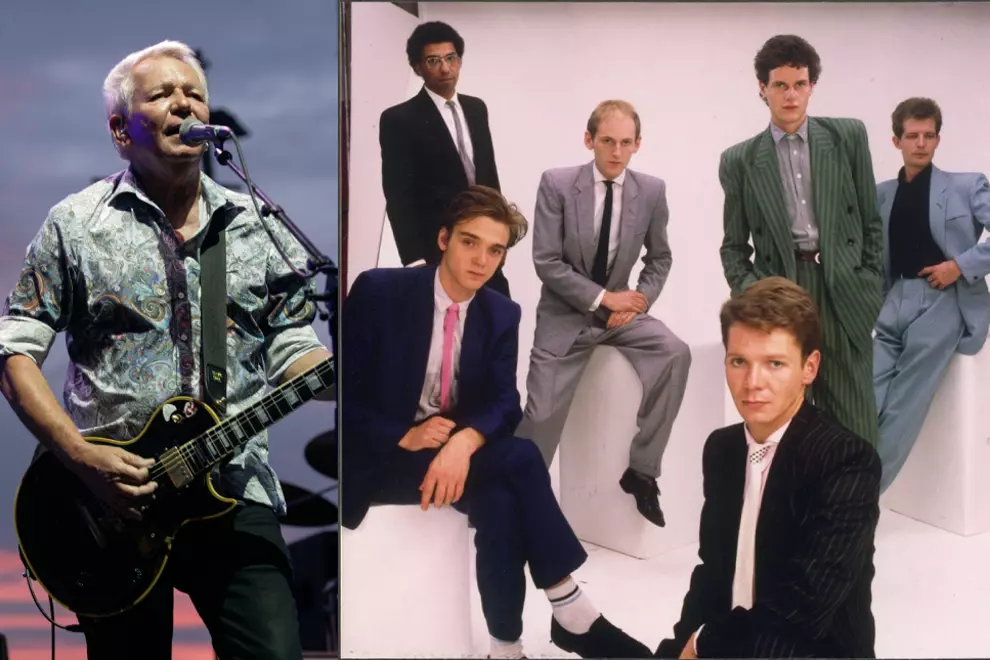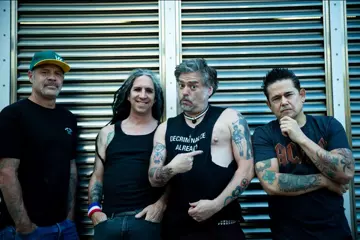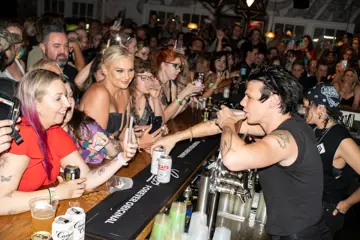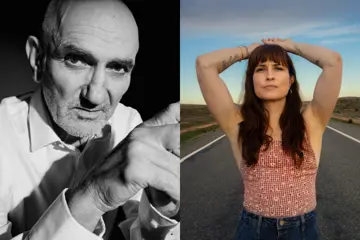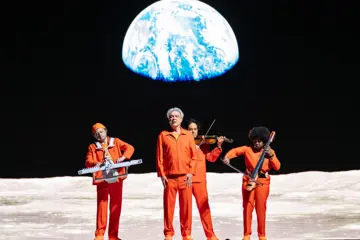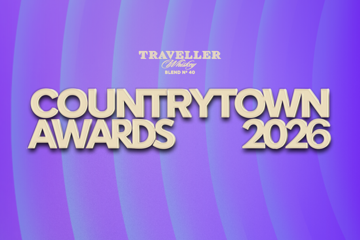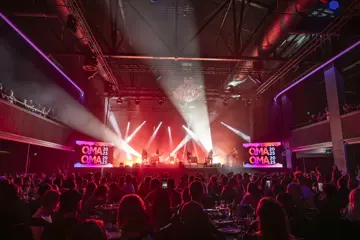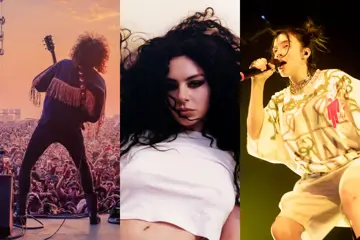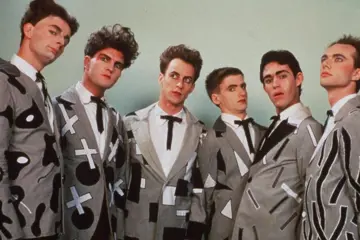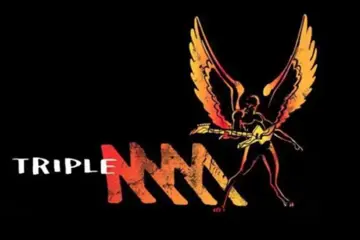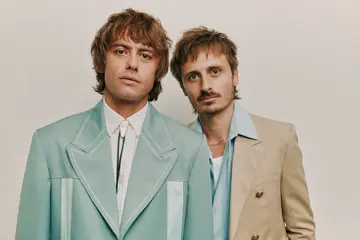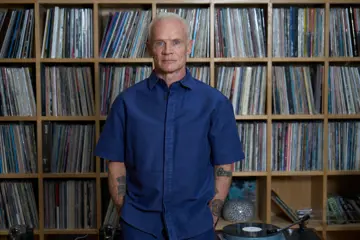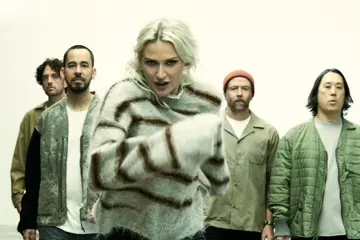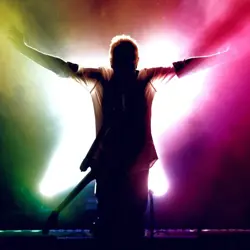 ICEHOUSE
ICEHOUSEThe aerial view that inspired Great Southern Land
“That flight over Australia on the way to our first international tour was pretty extraordinary because I looked out the window until it became desert and red soil and spinifex, and then gradually fell asleep. Then I woke up two hours later and opened my eyes and there it still was! I really couldn’t believe the size of [Australia], you know? That was the thing.”
The “magnetic draw” of Uluru
“Once you get over that sort of country, it’s pretty incredible. And then, of course, we flew across Lake Eyre – I don’t know what that’s called these days [Kati Thanda–Lake Eyre] – but that was incredible, as well. [Uluru] is a magical place. I don’t know; it’s just once you’re there, you can’t stop looking at it. It’s kind of strange; it’s got an incredible magnetic draw about it.”
The logistics of putting on a show in the outback
“The logistics of putting on a show in Uluru are pretty unbelievable. I mean, I’ve been working with the same tour manager since 1986, and he also happens to now be the general manager of Australia’s biggest production company. So his life’s work, besides tour managing us when we’re doing something, is organising the logistics of moving incredibly big PA and lighting rigs all around the place.
“And he started telling me how they were going to do it, and I kind of glazed over after a while because it just involves putting things on trains and then semi-trailers going across the desert and, you know, a whole lotta stuff that was kind of mind-boggling, really. And my brain went, ‘Oh, don’t! Just stop!’ you know? [laughs] I can’t imagine what’s involved in that, yeah. But when you think about it for two seconds, you realise, well, even getting enough power to run all that stuff out to a place like that is a major undertaking, and luckily for us, we do have this tour manager who is, as I say, a specialist in that kind of area. So hats off to Larry [Ponting] – I’ve been working with him a very long time.”
Trip the (Fair)light fantastic
Don't miss a beat with our FREE daily newsletter
“The story of [how I came to be one of the first to own a Fairlight] is actually almost unbelievable because our management company – for several years – had their offices in Kings Cross. And it was problematic for them because they were constantly being broken into and I sort of wasn’t even aware of this. But I went away on tour, and they moved offices while I was away on tour. They moved down to a two-storey building in Rushcutters Bay. And when I got back, they called me in for a meeting and then I had to find this place, and I did find it. And I got to the front door, and they had the upstairs storey – it wasn’t a terribly big building – and I didn’t even get to upstairs because there was a sign downstairs that said ‘CMI Fairlight’ and I knew exactly what they were.
“And I went in, and they recognised me – this was just after Primitive Man, our second album. So they said, ‘Oh, come out to the workshop out the back and meet all the guys that are building these things.’ So I literally got a guided tour of a whole lot of engineers with soldering irons and circuit boards and metal frames and so on. And, of course, they showed me what it could do.
“And I raced upstairs to the management meeting and said, ‘Do you know what they’re doing downstairs?’ And they said to me, ‘No’, ‘No’, ‘No’, ‘What’s going on downstairs?’ And I said, ‘They are building the most incredible machines, and I have to have one. And the catch is that it’s $32,000.’ So that was 1982 or ‘81 or something; that would buy you half a house back then.
“Anyway, the management company were kind of philosophical about it, and when I told them what it could do, they said, ‘Well, look, the way we figure it: it’ll pay for itself in the first two projects that you do.’ And in fact, the first thing I did on it was: I was invited to write the film score for an Australian movie called Razorback. So that was actually the first thing I did on the Fairlight, and, in actual fact, the Fairlight paid for itself in the first project that I did on it!
“But it became my main workstation for many, many years, and in fact, I was talking to my son about this a couple of nights ago. I had such a relationship with the engineers there that every time I wanted to try to get it to do something new, I would call them and say – and that was right from the beginning.
“The Fairlight had eight voices, so you could load, monophonically, eight sounds into it, and you could choose that to be all the same sound – so, you know, a violin and a violin and a violin and a violin and another one. And then you’d have a kinda eight-note chord of violin, so that’d be fine. Or the elements of a drum kit or whatever. But the problem with that was that it had incredibly wonderful sequencer software. So, in other words, a computer program whereby you could input notes and then you could edit them, and then you could get the machine to play it back for you—so very early days of that sort of thing.
“But what I wanted to do was to not only do one pass of it onto a tape but then go back and synchronise with itself into another pass and thereby build more than eight voices – build a whole load of stuff. And so I put that to the engineers at Fairlight, and they came up with a synchronising device that you could, you know, print this particular tone onto a piece of tape, and then you could do multiple passes of the Fairlight and load different things into it every time and so on.
“It was a sort of major addition to the Fairlight, and there were a couple of others along the way, too, that I got them to build. And so by the time I’d had the Fairlight a couple of years, it was very highly customised, and a lot of what we invented together, as it were, was then put into their future models of the Fairlight. So I had quite a close relationship with them, and I’d say they would readily admit that the way that we worked together vastly improved what they were building over time. So, yeah!
“And it amazes me that it’s not better recognised that this machine was an Australian invention, invented in the Sydney suburb of Fairlight. Because apart from the technology of recording itself, I believe very firmly that the sampler – which is what a Fairlight essentially is – was the biggest musical technology innovation that ever happened, and it was [invented by] a couple of mad Australians [laughs].”
The Fairlight “power users” club
“Probably about eight years ago, I was approached by Peter Vogel, who was one of the two mad scientists that invented the Fairlight, and he said to me, ‘Look, Peter Gabriel’s come up with an idea to raise money for this particular charity called Witness that he’s involved in, and the idea is that we’ve got hold of one of the original keyboards and we’ve taken all the keys out of it, and then we’re flying all over the world, and we’re getting all the original power users of the Fairlight to autograph a key, and then we’re going to put it all back together again, and we’re going to auction it.’
“Now, eventually, they did that, and I think they raised £100,000. Somebody bought that because the list of names is ridiculous, and I’m in there amongst these people. So, you know, Stevie Wonder, Kate Bush, Peter Gabriel, and an incredible list of people that used the Fairlight. So the combined value of all those signatures in one place was incredible. I’ve got a photo of that somewhere, and I’m honoured to be on that list of people because it was truly groundbreaking stuff.”
Bowie & Tin Machine play the Northern Beaches
“I live up in the Northern Beaches in Sydney, and down the road, about 100 metres, there’s a surf club, and it used to get bands playing there on the weekends. And then some neighbours complained and so on and that kind of all shut down. But I was living up here, and at that point in time, we were due to start recording the sixth album Code Blue in about three weeks. Then all of a sudden – due to unforeseen circumstances – the producer who we had booked was suddenly unavailable, and I was kind of panicking.
“And I also knew that David Bowie was recording in Sydney at a studio called Studio 301 – which is where we did a lot of recording, including the Flowers album [1980’s Icehouse album, back when the band was called Flowers] – and he was recording with his band Tin Machine.
“And I thought, ‘It’s an incredibly long shot, but I’ll call the studio and see whether he’ll call me back and give me a few ideas on producers that he’s worked with, and who might be available, and who might be good and who might not.’ So I called Studio 301 and left a message, and sure enough, I came home later in the afternoon – and it was the days of the old answering machine tapes – and there was a message there. And I pressed the play button, and a voice on the other end said [does his best Bowie impression], ‘Allo, Iva. It’s Dave here. Give me a call at the studio.’
“Anyway, I ended up speaking to him for at least an hour! It was down to business; it was down to a whole list of producers that I had in mind, people he’d worked with, and so on.
“But later that week, my sax player who lived in the city was due to come up for a weekend to stay with me. And he arrived at about six in the afternoon – it was summer – and he said, ‘Oh, I’ve been talking to the guys from Studio 301, and they reckon David Bowie and his band are gonna play at your local surf club tonight. And I went, ‘Yeah, get outta here. Come ooooon’ [laughs]. And, anyway, he said, ‘I’m just gonna walk down the road and have a bit of a look.’
“There was a phone box outside that surf club at that point, and so five minutes later, the phone rang, and there was Simon [Lloyd], my sax player, and he said, ‘He’s just arrived’ [laughs]. And I walked down the road to my surf club and watched David Bowie play for about 40 people, and then hung out with him afterwards and had a drink and then walked home! So I think that’s a bit of a story, yeah.”
Bowie sings along to Great Southern Land
“We were playing this series of German outdoor summer festivals, and then we were due to start [touring as support for] Bowie. We could only do the European/British leg of the tour because of other commitments; unfortunately, otherwise, it would’ve been great to sort of carry on to North America, and eventually, he got to Australia – that was by far the biggest tour he did. But, anyway, we were about a week away from starting with him, and we were playing this big festival, and we were on stage in Hamburg, and my bass player came over to me mid-song and kinda nudged me and said, ‘Don’t look now, but Dave’s over there.’ And I had absolutely no idea what he was talking about. And there was Bowie side of the stage, under a peaked cap, singing Great Southern Land along with me! I guess he’d been doing a bit of homework.
“Bowie had basically chosen us to be the support band, and I guess he happened to be in Germany and have a night off in the same place where we were playing and was checking our band out. I think our first show with him was either in Germany or Rotterdam – I’d have to go back and look at the records.”
To support Bowie or Peter Gabriel?
“We had to choose between [supporting] Peter Gabriel and David Bowie, unfortunately – we were offered both of those tours – and it was all off the back of a song called Hey Little Girl, which was a very high-charting hit in Europe. And so they both heard that song, and then I guess that had led them to – well, it certainly led Bowie to the album from which that came [Primitive Man], which of course also included Great Southern Land.”
Icehouse’s go-to soundcheck song
“This is entirely distinct from what the song is and may represent: by accident, a long time ago, we decided that [Great Southern Land] was the perfect soundcheck song; just as a kind of sonic phenomenon. We discovered by, I guess, trial and error that if we get that song sounding right – and it’s actually a straightforward song, there’s nothing incredibly complicated about it – then everything else is gonna sound right.
“I mean, if you were to have the phone numbers of all of the band members now, and out of the blue completely blindside-called them and said, ‘What’s the soundcheck song?’ They’d all give you the answer straight away [laughs]; every single one of them – and the crew. So that’s what we do and, yeah! Weirdly, Great Southern Land is kind of our identity.”
Move over, Electric Blue
“Prior to the eve of the year 2000, if you had’ve got an honest answer from me in all of those years [to the question] ‘What is it that’s gonna be on your tombstone?’ It would’ve been Electric Blue because it was the highest-charting song that we ever had. And that does seem to be the defining song, and it certainly was the reality.
“Then, of course, I was commissioned by the City of Sydney to develop Great Southern Land into a massive 25-minute orchestral extravaganza, which featured Richard Tognetti on electric violin and a brilliant set of drummers from Sydney who played traditional Japanese drums, and it became a piece called The Ghost Of Time: that was the accompaniment to the 25 minutes leading up to the countdown into the year 2000.
“So it was broadcast out to four million people, I think it was, worldwide. And, of course, it culminates in a version of Great Southern Land. And from that moment on, and ever since, suddenly, like a great sleeping giant, Great Southern Land was woken. So now everything has changed. It’s quite strange to have gone through a very long period of my life thinking, ‘Oh, okay, yep, well what people remember is Electric Blue and then suddenly have that change overnight, virtually.”
Great Southern Land Byrralku Dhangudha remix
“The conduit for that was Stephen Page, and Stephen Page, of course, was the artistic director of Bangarra up until quite recently – for decades. And, of course, I met him way back – not with the first score that I wrote for the Sydney Dance Company, but certainly, he was there. And I was there when Stephen announced that his son [Hunter Page-Lochard] – who is now doing incredibly well as a film and television actor – had been born. And I knew his mother – she was one of the dancers with the Sydney Dance Company – so, yeah! That was the relationship with Stephen Page, and he brought a number of people from Bangarra to a little studio in Camperdown, and that was where that [remix] was done. And those guys translated it [into indigenous language] and so on, so, yeah, it was a bit of a collaborative project.”
Michael Paynter as honorary Man Of Colours
“Look, it’s pretty hard to go past Michael’s live version of Man Of Colours, and it’s incredibly interesting from my point of view to be able to stand back and listen to how somebody else hears the song. And he genuinely loves this song, so you can tell that it’s treated with great respect.
“Michael’s got a completely different voice to me, and an incredible voice, but the exercise was always for him to really own it himself, to do the Michael Paynter version, which he does.”
Icehouse meet The Psychedelic Furs
“On the very first international tour that we did, we actually did play with The Psychedelic Furs in Atlanta, in America, in a club somewhere. They probably won’t even remember. And I think one of the reasons I remember is because it was the first time I ever saw a rock‘n’roll band with a saxophone player! And, anyway, I was a fan very early on.”
The Psychedelic Furs cover that scored contemporary dance
“In 1995, I came up with the idea of doing a covers album and did versions of things by lots of my favourite people, including David Bowie and, you know, a Talking Heads song and a Lou Reed/Velvet Underground song and a Roxy Music song and so on. And one of the songs was a song called Sister Europe, which is a fairly early Psychedelic Furs song.
“And I was working on this covers album with a friend of mine [Max Lambert] who is an extraordinarily brilliant pianist, and I said to him, ‘Max, I can see these on stage with the Sydney Dance Company.’ And Max had an association with Sydney Dance Company, as I did, so we sent a number of the songs to Graeme Murphy, and he loved the idea. And so we created a score for a ballet that became a ballet called Berlin, and woven into the score were seven of these cover versions, including Sister Europe by The Psychedelic Furs.
“And Max and I performed every night live as part of the show at the Sydney Opera House and toured to New Zealand and all over the place, and we went with it. So I have sung a Psychedelic Furs song many, many, many, many, many times [laughs]. So I’ll be interested in sitting down with them, if I get a chance, and tell them that because I’m sure that they never envisaged that one of their songs would end up in a contemporary dance work.”
ICEHOUSE
TOUR DATES
Saturday, 19 November 2022 - Sidney Myer Music Bowl, Melbourne (with Psychedelic Furs, Mark Seymour & The Undertow, Motor Ace and Emma Donovan & The Putbacks)
Saturday, 26 November 2022 - Riverstage, Brisbane (with Psychedelic Furs and Alice Skye)
Monday, 12 December 2022 - Sydney Opera House Forecourt (with Mark Seymour & The Undertow, William Barton and Karen Lee Andrews)
4-6 July 2023 - Big Red Bash Festival, Birdsville, QLD
17-19 August 2023 - Mundi Mundi Bash Festival, Broken Hill, NSW

